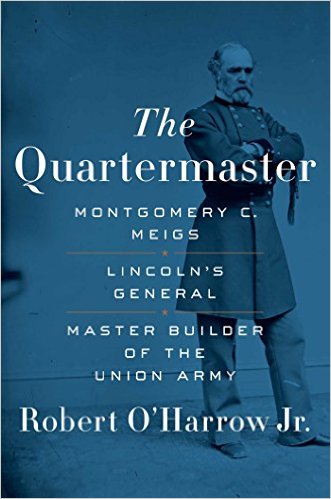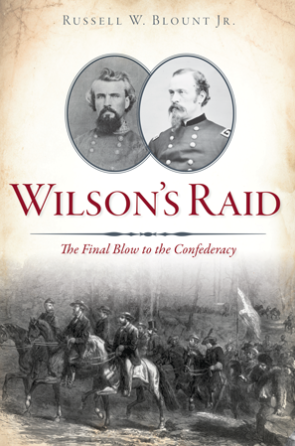The Quartermaster: Montgomery C. Meigs, Lincoln’s General, Master Builder of the Union Army by Robert O’Harrow, Jr. Simon & Schuster, 2016. Cloth, ISBN: 978-1451671926. $28.00.
 When President Chester A. Arthur forced General Montgomery Meigs into retirement in 1882 at the age of sixty-five, a sense of loss permeated the minds of many Union veterans. After forty-five years of loyal service to the federal government, the renowned quartermaster general who proved a critical element of Union success was being forced out. To many Union veterans—from privates to generals—Meigs was a father-like figure who created a logistical system second to none. General William Tecumseh Sherman, a beneficiary of Meigs’ genius, particularly during his campaign in Georgia, observed after receiving news of Meigs’ forced retirement: “We all feel like orphans losing the Quartermaster General.”
When President Chester A. Arthur forced General Montgomery Meigs into retirement in 1882 at the age of sixty-five, a sense of loss permeated the minds of many Union veterans. After forty-five years of loyal service to the federal government, the renowned quartermaster general who proved a critical element of Union success was being forced out. To many Union veterans—from privates to generals—Meigs was a father-like figure who created a logistical system second to none. General William Tecumseh Sherman, a beneficiary of Meigs’ genius, particularly during his campaign in Georgia, observed after receiving news of Meigs’ forced retirement: “We all feel like orphans losing the Quartermaster General.”
Despite the reverence countless individuals felt for Meigs, his prominent role in Union victory, and his role as the mastermind behind numerous construction projects in our nation’s capital, Meigs has, sadly, been forgotten. Not until 1959 did a full-length biography of Meigs appear: Russell F. Weigley’s Quartermaster General of the Union Army: A Biography of M.C. Meigs. The importance of Weigley’s study notwithstanding, Meigs remained an obscure figure. Now, nearly two generations since Weigley’s volume, author Robert O’Harrow, Jr., brings Meigs out of the shadows once more, giving him his due as one of the most important figures who guided the Union war effort to victory.
O’Harrow, a writer for the Washington Post and two-time Pulitzer Prize finalist, has produced an excellent biography. Based on a wide array of primary (both published and manuscript) and secondary sources, the author does an admirable job of chronicling Meigs’ fascinating life from his childhood in Augusta, Georgia, and Philadelphia, Pennsylvania, to his career as a student of the West Point class of 1836. The author’s literary style offers a flowing narrative of Meigs’ many contributions to this nation before, during, and after the Civil War.
The author masterfully traces Meigs’ role in a variety of endeavors in the decades prior to the conflict. Whether overseeing such projects as the Washington Aqueduct, supervising the construction of the Capitol’s new dome, or strengthening defenses near the Canadian border, O’Harrow convincingly argues that these opportunities were an education for Meigs, one which aided him in his eventual role as quartermaster general. The various projects Meigs managed prior to the war not only offered him the opportunity to hone his organizational, administrative, and logistical skills, but also provided him the skillset required to deal with politicians during our nation’s most turbulent period.
At the heart of O’Harrow’s volume are Meigs’ seemingly incalculable contributions to the Union war effort. Not only does the author illustrate the speed and precision with which Meigs and his department was able to supply Union troops in the field, but O’Harrow clearly shows how those efforts led directly to Union successes in such notable engagements as Fort Henry, Gettysburg, and Sherman’s campaign in Georgia.
Beyond enumerating Meigs’ significant role in the conflict, which also included offering strategic advice to President Abraham Lincoln, the author’s careful analysis of Meigs’ writings offer numerous insights into the mind of the man Secretary of State William Seward labelled the nation’s “eminent soldier.” O’Harrow convincingly shows that Meigs always leaned on “inspiration from the past” to cope with the challenges of the present (21). For example, when confronted with the task of meeting the demands for clean water in the nation’s capital, he drew on the writings of Sextus Julius Frontinus who, seventeen centuries before Meigs’ birth, designed the aqueducts of Rome.
While the author notes that Meigs always strived for excellence in his work, an obsession that occasionally transformed him into irritable brute, Meigs’ family proved to be his ultimate passion. Meigs not only had to navigate the tasks of his career, but also cope with the incomprehensible horrors of burying three of his children, two of whom died before the conflict. The third, John Rodgers Meigs, was killed in October 1864 outside of Dayton, Virginia, while serving as a member of Gen. Philip H. Sheridan’s staff in the Shenandoah Valley. That singular event, more than any other in his life, proved a hurdle that Meigs could not overcome. The author asserts that this moment prompted Meigs to shut out longtime friends whose wartime allegiance rested with the Confederacy. When some of those former friends such as Alfred Rives, who worked with Meigs on the Washington Aqueduct, or Varina Davis, wife of former Confederate president Jefferson Davis, sought his help or reunion after the war, he refused to see or assist them as they were connected to, in Meigs’ words, “‘the party who murdered my son’” (233).
While this book presents a compelling narrative and sharp analysis of Meigs’ life, it offers a great deal more to Civil War historians than simply a witty critique of one of the Civil War’s most significant figures. Historians interested in the operations of the quartermaster department during the Civil War, particularly purchasing and distribution practices, will find this volume extremely useful. Additionally, O’Harrow’s volume offers insights into the hatred that existed among some political figures in the federal government toward West Pointers—and how professional soldiers like Meigs navigated those complexities.
O’Harrow certainly writes with a gifted pen, but the inclusion of images, such as one of the monument placed over John Rodgers Meigs’ grave at Arlington National Cemetery, would only deepen the book’s richness and offer a visual manifestation, for readers unfamiliar with the macabre memorial, of Meigs’ sorrow.
That minor quibble aside, O’Harrow’s thorough, masterfully crafted, and impeccably researched biography is destined to become the authoritative volume on Meigs. Hopefully, this superb biography will rescue Meigs from the historical shadows and place him among the pantheon of great Union leaders—Abraham Lincoln, Ulysses S. Grant, Philip H. Sheridan, and William T. Sherman.
Jonathan A. Noyalas, the author or editor of eleven books on Civil War era history, is the director of the McCormick Civil War Institute at Shenandoah University, where he also teaches courses in Civil War era studies.
